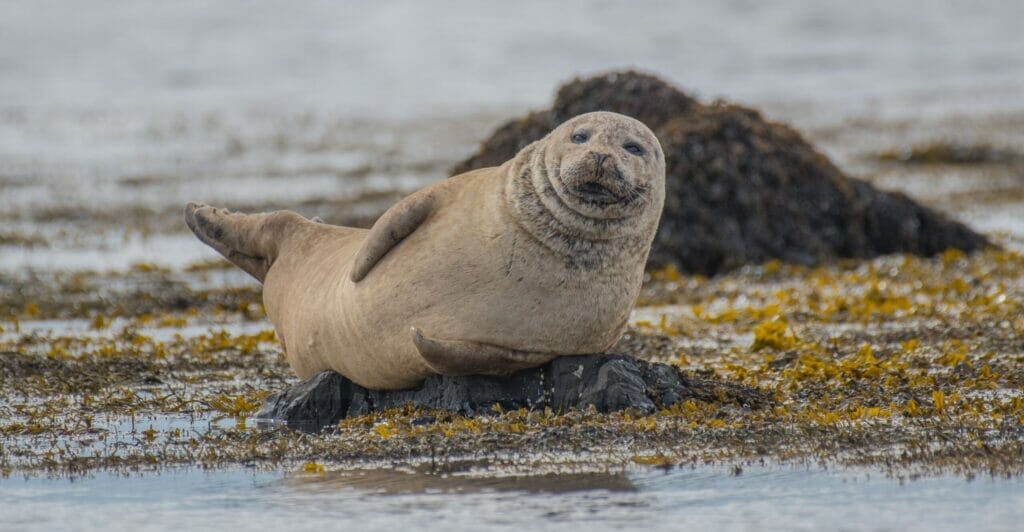Sharks fascinate many people and are probably one of the most famous sea creatures. Mostly they are known for their impressive predatory abilities, but do you already know the Greenland shark? What makes it special is that it is the longest living vertebrate known, with at least 400 years. Hard to believe and incredibly fascinating as we find. In the following you will learn more about this unique sea inhabitant.
What Is So Special About the Greenland Shark?
The Longest Living Vertebrate
On the Atlantic island of St. Helena lives Jonathan, a Seychelles giant tortoise, which is approximately year 1832 making him one of the oldest, if not the oldest land animal, at about 190 years old. But much further north in the Atlantic there is a sea creature that can only smile about such an age. We are talking about the Greenland shark (Somniosus microcephalus), also known as gurry shark or grey shark, which belongs to the family Somniosidae. Somniosidae means as much as the drowsy one which is taken literally as the Greenland shark usually travels only one km/h per hour and even on predation not more than 2.6 km/h. However, it has no reason to hurry, as it is the oldest known vertebrate on our planet with at least 400 years of life recorded. Researchers also believe 500 years is possible, but not much is known about this shark due to its remote, extreme habitats.
An Extreme Habitat
The Greenland shark, as the name suggests, is primarily native to the remote Arctic areas of the Atlantic, but there are rare sightings of animals as far south as the Bay of Biscay. These sharks can be found in water depths of over 2000 meters and in water temperatures between -2 and 7 degrees Celsius. With such extreme habitats, it is obvious that this makes research on the animals very difficult and therefore much is still unknown about these animals.

A True Giant
What is known, however, is that the animals can reach a length of almost 8 meters and a weight of up to 2.5 tons and thus also belong to the largest sharks known to us. Together with the torpedo-shaped body, which you can see well in the title image of this article, the Greenland shark definitely has an impressive appearance.
Learn More About How the Greenland Shark Lives
Reproduction and Development
Greenland sharks hatch from eggs while still in the mother’s body and are then born, a process known as ovoviviparity. The gestation period is estimated between 8 and 18 years, and about 10 pups per litter are normal with a fairly large body length of around 40 cm. Initial growth is maximum and then steadily decreases until then from the second half of the natural life span growth is well below 1 cm in body length per year. The sharks do not reach sexual maturity until they are at least 150 years old, when their average length is about 4 meters.
So, the Greenland sharks go through their development very slowly, but what is interesting is that the brains of the sharks also hardly age or age very slowly, Alzheimer’s does not seem to be a problem with them. Researchers found this out when they examined a Greenland shark brain (you can read more about this study here).
Diet
As is generally known for sharks, they are not particularly picky when it comes to food. Greenland sharks eat all kinds of fish and in particular the smaller sharks like to hunt squid. Seals are also on the menu and even remains of polar bears, reindeer, horses, and other large land animals have been found in their stomachs.
As mentioned above, Greenland sharks usually only swim around 1 km/h and in hunting situations up to 2.6 km/h and therefore it is surprising that they still catch a lot of prey that normally moves much faster than them. The researchers assume that the Greenland sharks surprise their prey mainly when they are sleeping.

In addition, most of them have very limited eyesight, because their eyes are often infested with parasites leaving their eyes totally scarred. Nevertheless, this hardly limits them in their hunting abilities, as they must rely on other senses in the dark depths anyway.
Predators
Due to their enormous size and outstanding abilities, Greenland sharks do not have too many predators. But it is believed that both sperm whales as well as orcas can be dangerous to them. In addition, of course, they are also endangered by us humans, more about this further below.
Greenland Sharks and Humans
Encounters
Because Greenland sharks tend to stay in very remote and extreme areas where few people are around, let alone in the water, there are no documented attacks on humans. But purely based on their physical attributes, an attack on a human could definitely be fatal. In 1859, a specimen was reportedly caught in Pond Inlet with a half-digested human leg in its stomach, but this incident has never been scientifically investigated.
Use As Food
Without special preparation, the meat cannot be eaten because it contains Trimethylamine N-oxide, which is broken down during digestion to the toxic Trimethylamine. Only after fermentation is the meat edible, which is a specialty in Iceland called Hákarl. In addition, in Iceland and Greenland, the dried meat of a Greenland shark is also fed to dogs.
Threats
Until the 1960s, the Greenland shark was still hunted for its liver, from which oil could be extracted for use as lubricant or fuel. Nowadays, the animals are caught mainly as bycatch in large industrial fisheries and are no longer directly targeted. However, private fishermen in the Arctic still play a role in catching Greenland sharks.
However, due to extremely slow and limited reproduction and limited knowledge regarding population size, the Greenland shark is classified as vulnerable on the IUCN list. In addition, global warming poses an additional threat to the population.
In the video below you can see some rare footage of a Greenland shark and you get an idea of what it looks like.
Marine Life Is Simply Unbelievable
We hope you enjoyed this brief overview of this truly fascinating shark. It is always incredible what kind of creatures are out there in the marine environment and live under circumstances that we can hardly imagine. Who knows what we will learn in the future about marine life in the deep? After all, we have only been able to explore a fraction of it so far and we are sure that there are still many exciting discoveries waiting for us.
By the way, the first time we heard about the Greenland shark was when we read the fantastic book “Shark Drunk: The Art of Catching a Large Shark from a Tiny Rubber Dinghy in a Big Ocean” by Morten Strøksnes (ISBN-10: 1784704342). We at Maritime Affection read the German translation at that time and were thrilled. We are sure that the English translation is also great. In any case, we can only recommend it and such a book is of course always great as a gift among maritime enthusiasts.










